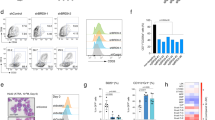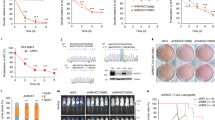Abstract
BRD4, a major tandem-bromodomain-containing transcription regulator, has two isoforms. The long isoform (BRD4L) has an extended C terminus that binds transcription cofactors, while the short isoform (BRD4S) lacks this C-terminal extension. Unlike BRD4L, the role of BRD4S in gene transcription remains unclear. Here, we report that, in human cancer cells, BRD4S forms nuclear puncta that possess liquid-like properties and that colocalize with BRD4L, MED1 and sites of histone H3 lysine 27 acetylation. BRD4 puncta are correlated with BRD4S but not BRD4L expression levels. BRD4S knockdown reduces BRD4S condensation, and ectopic expression promotes puncta formation and target gene transcription. BRD4S nuclear condensation is mediated by its intrinsically disordered regions and binding of its bromodomains to DNA and acetylated chromatin, respectively, and BRD4S phosphorylation diminishes BRD4 condensation. Our study illuminates a previously unappreciated role of BRD4S in organizing chromatin and transcription factors through phase separation to sustain gene transcription in chromatin for cancer cell proliferation.
This is a preview of subscription content, access via your institution
Access options
Access Nature and 54 other Nature Portfolio journals
Get Nature+, our best-value online-access subscription
$29.99 / 30 days
cancel any time
Subscribe to this journal
Receive 12 print issues and online access
$189.00 per year
only $15.75 per issue
Buy this article
- Purchase on Springer Link
- Instant access to full article PDF
Prices may be subject to local taxes which are calculated during checkout






Similar content being viewed by others
References
Wu, S. & Chiang, C. The double bromodomain-containing chromatin adaptor Brd4 and transcriptional regulation. J. Biol. Chem. 282, 13141–13145 (2007).
Dhalluin, C. et al. Structure and ligand of a histone acetyltransferase bromodomain. Nature 399, 491–496 (1999).
Zaware, N. & Zhou, M. M. Bromodomain biology and drug discovery. Nat. Struct. Mol. Biol. 26, 870–879 (2019).
Shi, J. et al. Disrupting the interaction of BRD4 with diacetylated twist suppresses tumorigenesis in basal-like breast cancer. Cancer Cell 25, 210–225 (2014).
Wang, R., Li, Q., Helfer, C. M., Jiao, J. & You, J. Bromodomain protein Brd4 associated with acetylated chromatin is important for maintenance of higher-order chromatin structure. J. Biol. Chem. 287, 10738–10752 (2012).
Wu, T., Kamikawa, Y. F. & Donohoe, M. E. Brd4’s bromodomains mediate histone H3 acetylation and chromatin remodeling in pluripotent cells through P300 and Brg1. Cell Rep. 25, 1756–1771 (2018).
Whyte, W. A. et al. Master transcription factors and mediator establish super-enhancers at key cell identity genes. Cell 153, 307–319 (2013).
Rahnamoun, H. et al. RNAs interact with BRD4 to promote enhanced chromatin engagement and transcription activation. Nat. Struct. Mol. Biol. 25, 687–697 (2018).
Zanconato, F. et al. Transcriptional addiction in cancer cells is mediated by YAP/TAZ through BRD4. Nat. Med. 24, 1599–1610 (2018).
Han, T. W. et al. Cell-free formation of RNA granules: bound RNAs identify features and components of cellular assemblies. Cell 149, 768–779 (2012).
Kato, M. et al. Cell-free formation of RNA granules: low complexity sequence domains form dynamic fibers within hydrogels. Cell 149, 753–767 (2012).
Banani, S. F., Lee, H. O., Hyman, A. A. & Rosen, M. K. Biomolecular condensates: organizers of cellular biochemistry. Nat. Rev. Mol. Cell Biol. 18, 285–298 (2017).
Li, P. et al. Phase transitions in the assembly of multivalent signalling proteins. Nature 483, 336–340 (2012).
Larson, A. G. et al. Liquid droplet formation by HP1ɑ suggests a role for phase separation in heterochromatin. Nature 547, 236–240 (2017).
Strom, A. R. et al. Phase separation drives heterochromatin domain formation. Nature 547, 241–245 (2017).
Shin, Y. et al. Liquid nuclear condensates mechanically sense and restructure the genome. Cell 175, 1481–1491.e13 (2018).
Zhang, Q. et al. Visualizing dynamics of cell signaling in vivo with a phase separation-based kinase reporter. Mol. Cell 69, 334–346.e4 (2018).
Sabari, B. R. et al. Coactivator condensation at super-enhancers links phase separation and gene control. Science 361, eaar3958 (2018).
Cho, W.-K. et al. Mediator and RNA polymerase II clusters associate in transcription-dependent condensates. Science 361, 412–415 (2018).
Gibson, B. A. et al. Organization of chromatin by intrinsic and regulated phase separation. Cell 179, 470–484.e21 (2019).
Ren, C. et al. Spatially constrained tandem bromodomain inhibition bolsters sustained repression of BRD4 transcriptional activity for TNBC cell growth. Proc. Natl Acad. Sci. USA 115, 7949–7954 (2018).
Tzelepis, K. et al. SRPK1 maintains acute myeloid leukemia through effects on isoform usage of epigenetic regulators including BRD4. Nat. Commun. 9, 5378 (2018).
Creyghton, M. P. et al. Histone H3K27ac separates active from poised enhancers and predicts developmental state. Proc. Natl Acad. Sci. USA 107, 21931–21936 (2010).
Conrad, R. J. et al. The short isoform of BRD4 promotes HIV-1 latency by engaging repressive SWI/SNF chromatin-remodeling complexes. Mol. Cell 67, 1001–1012.e6 (2017).
Hnisz, D., Shrinivas, K., Young, R. A., Chakraborty, A. K. & Sharp, P. A. A phase separation model for transcriptional control. Cell 169, 13–23 (2017).
Miller, T. C. et al. A bromodomain–DNA interaction facilitates acetylation-dependent bivalent nucleosome recognition by the BET protein BRDT. Nat. Commun. 7, 13855 (2016).
Wu, S. Y., Lee, A. Y., Lai, H. T., Zhang, H. & Chiang, C. M. Phospho switch triggers Brd4 chromatin binding and activator recruitment for gene-specific targeting. Mol. Cell 49, 843–857 (2013).
Sigova, A. A. et al. Transcription factor trapping by RNA in gene regulatory elements. Science 350, 978–981 (2015).
Du, M. & Chen, Z. J. DNA-induced liquid phase condensation of cGAS activates innate immune signaling. Science 361, 704–709 (2018).
Wu, S. Y. et al. BRD4 phosphorylation regulates HPV E2-mediated viral transcription, origin replication, and cellular MMP-9 expression. Cell Rep. 16, 1733–1748 (2016).
Carey, M. F., Peterson, C. L. & Smale, S. T. Dignam and Roeder nuclear extract preparation. Cold Spring Harb. Protoc. https://doi.org/10.1101/pdb.prot5330 (2009).
Voss, C. et al. A novel, non-radioactive eukaryotic in vitro transcription assay for sensitive quantification of RNA polymerase II activity. BMC Mol. Biol. 15, 7 (2014).
Dignam, J. D., Lebovitz, R. M. & Roeder, R. G. Accurate transcription initiation by RNA polymerase II in a soluble extract from isolated mammalian nuclei. Nucleic Acids Res. 11, 1475–1489 (1983).
Acknowledgements
We thank C.-M. Chiang of UT Southwestern Medical Center for providing valuable BRD4S-specific antibody and BRD4 mutant plasmids, S. Fu of the First Hospital at Jilin University for cancer cell lines, R.G. Roeder of Rockefeller University for helpful discussion and F. Wang and J. Zhang for assistance with microscopy. We thank the State Key Laboratory of Supramolecular Structure and Materials at Jilin University for the use of their research facilities. This work was supported in part by the research fund from the First Hospital of Jilin University (Changchun, China); the Open Project of the State Key Laboratory for Supramolecular Structure and Materials, JLU (grant no. SKLSSM201602); the JLU Science and Technology Innovative Research Team (grant no. JLUSTIRT, grant no. 2017TD-25); the International Center of Future Science, JLU; and the National Natural Science Foundation of China (grant no. 31770780; L.Z.).
Author information
Authors and Affiliations
Contributions
L.Z. and M.-M.Z. conceived the project. X.H. and Q.W. performed BRD4 LLPS experiments. D.Y. and M.Y. performed BRD4 knockdown, transfection and microscopic imaging experiments in cells. R.G. performed EMSA and thermal shift assays. Y.J., X.Y., C.Z., H.Y., A.J. and Q.Z. performed protein expression and purification. N.B. contributed to florescence anisotropy and mass spectrometry studies. L.Z. and M.-M.Z. wrote the manuscript with input from all of the coauthors.
Corresponding authors
Ethics declarations
Competing interests
M.-M.Z. is a founder, director and shareholder of Parkside Scientific Inc.
Additional information
Peer review information Beth Moorefield was the primary editor on this article and managed its editorial process and peer review in collaboration with the rest of the editorial team.
Publisher’s note Springer Nature remains neutral with regard to jurisdictional claims in published maps and institutional affiliations.
Supplementary information
Supplementary Information
Supplementary Figs. 1–10 and Tables 1–6.
Supplementary Video 1
A movie showing BRD4 GFP–BD2–CPS liquid droplets. Droplets were formed by GFP–BD2–CPS (21 μM) in 65 mM NaCl and 2% PEG-6000 and were observed at room temperature with an upright Zeiss (Germany) confocal microscope using a ×63 oil immersion lens. The movie is represented as 8.8-fold speed-up. Scale bars, 10 μm.
Rights and permissions
About this article
Cite this article
Han, X., Yu, D., Gu, R. et al. Roles of the BRD4 short isoform in phase separation and active gene transcription. Nat Struct Mol Biol 27, 333–341 (2020). https://doi.org/10.1038/s41594-020-0394-8
Received:
Accepted:
Published:
Issue Date:
DOI: https://doi.org/10.1038/s41594-020-0394-8
This article is cited by
-
Crosstalk between protein post-translational modifications and phase separation
Cell Communication and Signaling (2024)
-
Predicting nuclear G-quadruplex RNA-binding proteins with roles in transcription and phase separation
Nature Communications (2024)
-
BRD4 isoforms have distinct roles in tumour progression and metastasis in rhabdomyosarcoma
EMBO Reports (2024)
-
BRD4-targeting PROTAC as a unique tool to study biomolecular condensates
Cell Discovery (2023)
-
SGF29 nuclear condensates reinforce cellular aging
Cell Discovery (2023)



